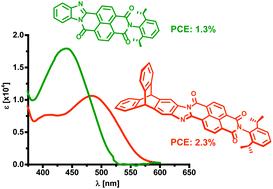Planar versus triptycenylene end-capped aroyleneimidazoles as electron acceptors in organic photovoltaics†
Abstract
The effect of triptycenylene end-groups on the optoelectronic properties of aroyleneimidazoles and their performance as acceptors in bulk heterojunction photovoltaic devices are described. We compare three derivatives of triptycene monoaroyleneimidazoles with their planar analogues. Planar aroyleneimidazoles show rather poor performance as acceptors with power conversion efficiencies (PCEs) of ∼0.3–1.3%. In contrast, the triptycene end-capped congeners show improved performance with a maximum PCE of 2.3%, demonstrating the potential of triptycene-based π-systems for application as non-fullerene electron acceptors.

- This article is part of the themed collection: Novel π-electron molecular scaffolds

 Please wait while we load your content...
Please wait while we load your content...